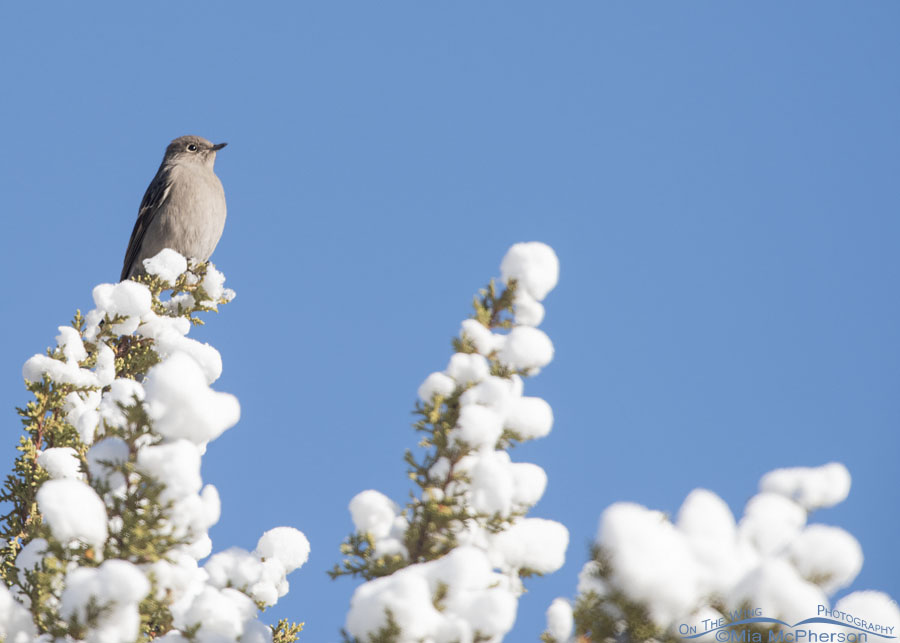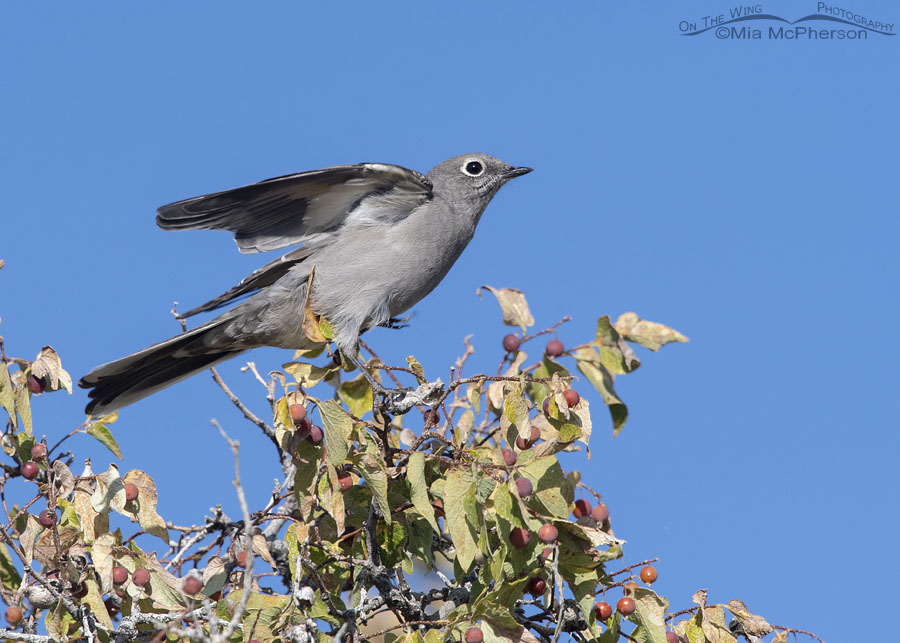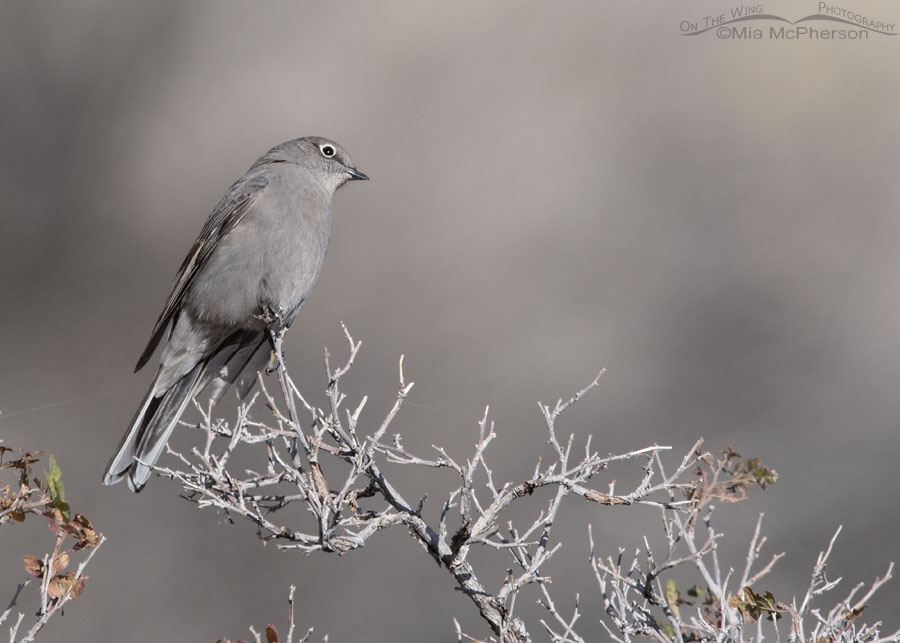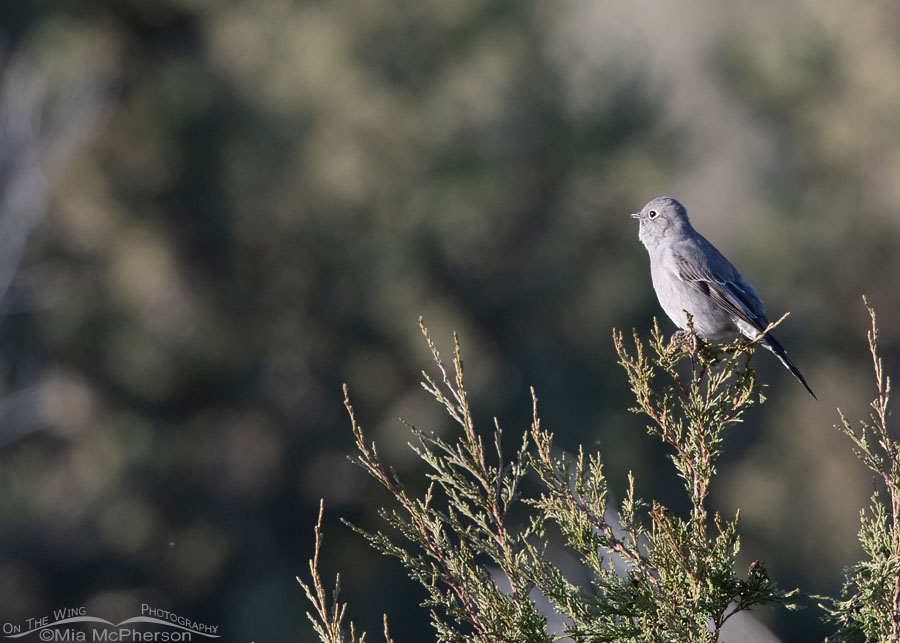In 2024, the common name for Townsend’s Solitaire will change, along with many other bird names. My recommendation would be to rename it the Juniper Solitaire.
On November 1st, the American Ornithological Society (AOS) announced its intention to change all English-language names of birds within its geographic jurisdiction that are directly named after people.
 Townsend’s Solitaire perched on a snowy juniper – Nikon D810, f7.1, 1/1250, ISO 640, =1.0 EV, Nikkor 500mm VR with 1.4x TC, natural light
Townsend’s Solitaire perched on a snowy juniper – Nikon D810, f7.1, 1/1250, ISO 640, =1.0 EV, Nikkor 500mm VR with 1.4x TC, natural light
These solitaires, which are small gray thrushes, are are found in the western half of North America from as far north as Alaska to as far south as Mexico. They aren’t flashy birds, but for me, they are gorgeous and I think their songs and calls are wonderful. I adore hearing these solitaires.
 Autumn Townsend’s Solitaire in a hackberry tree – Nikon D500, f7,1, 1/1000, ISO 500, =0.7 EV, Nikkor 500mm VR with 1.4x TC, natural light
Autumn Townsend’s Solitaire in a hackberry tree – Nikon D500, f7,1, 1/1000, ISO 500, =0.7 EV, Nikkor 500mm VR with 1.4x TC, natural light
I find these solitaires high in the mountains during the warmer months. In fall, as they move to lower elevations, I locate them in various locations, including desert ranchlands as low as the edges of the Great Salt Lake and in the foothills of sky island mountain ranges in the West Desert.
 Roadside Townsend’s Solitaire in a Fragrant Sumac – Nikon D500, f7.1, 1/2000, ISO 640, Nikkor 500mm VR with 1.4x TC, natural light
Roadside Townsend’s Solitaire in a Fragrant Sumac – Nikon D500, f7.1, 1/2000, ISO 640, Nikkor 500mm VR with 1.4x TC, natural light
I usually hear these small, gray thrushes before I see them. Their songs and calls quite often help me locate them in the field.
But I digress, to get to my point about renaming them Juniper Solitaires I want to address their diet and preferred habitats.
 Fall Townsend’s Solitaire in the West Desert – Nikon D500, f7.1, 1/500, ISO 800, -0.7 EV, Nikkor 500mm VR with 1.4x TC, natural light
Fall Townsend’s Solitaire in the West Desert – Nikon D500, f7.1, 1/500, ISO 800, -0.7 EV, Nikkor 500mm VR with 1.4x TC, natural light
These solitaires depend on juniper berries in their diet to get through hard, cold winters. Townsend’s Solitaires are known to eat between 42,000 and 84,000 juniper berries to survive the winter. They almost exclusively feed on juniper berries during the nonbreeding season.
The preferred habitats of this solitaire species include pines, firs, montane coniferous forests, and in winter open juniper forests.
Yes, I find them in other habitats but the fact is that they need juniper berries and juniper forests in the winter to survive and thrive. It makes perfect sense to me, to rename them the Juniper Solitaire.
Your opinion may vary, but I adore that name and it is easy to remember.
Life is good.
Mia
Click here to see more of my Townsend’s Solitaire photos plus facts and information about this species.


Nice series of pics. Love the eye contact and the composition of each shot. “Juniper” Solitaire works for me too. Thanks Mia.
I definitely agree.The photo of the jupiter solitaire on the sumac is really special with the grey background.
I definitely agree.
Your suggestion makes a heap of sense to me. That is a LOT of juniper berries they need to survive.
Great birds. Unfortunately their winter habitat – where they establish winter territories and sing around berry-laden juniper trees is being decimated by BLM and USFS “vegetation treatments” across the Interior West. It is sickening to witness the purposeful deforestation taking place.
Katie I agree, it is sickening to see the Juniper forests being attacked by the BLM and USFS along with private property holders too. What makes me even sicker is to see it being done during the nesting season which I have seen for the past 3 or 4 years.
So glad to know about this bird and it’s name change.-Jeri S.
Sure makes sense! Easy to remember, and connects the bird to its habit rather than a human being’s name.
“Juniper Solitaire” sounds like a great common name suggestion! I don’t see these birds often, but have only seen them in Juniper type habitats in foothills during winter. Regardless, what beautiful photos of a lovely bird. Thanks.